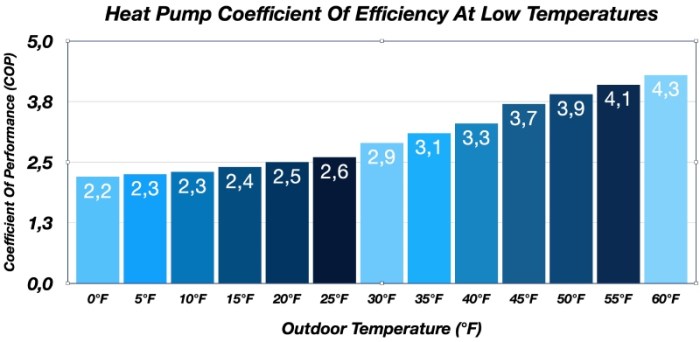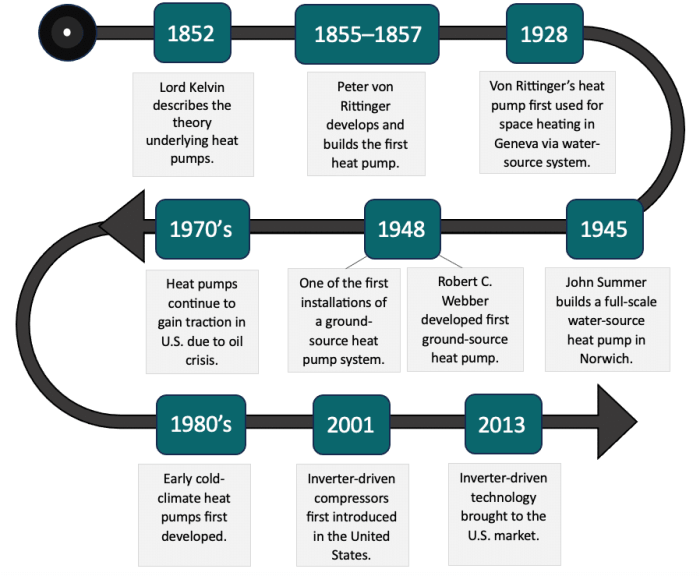EV heat pump efficiency in cold climates? Yeah, that’s a big deal. Think about it: electric cars are supposed to be green, but if your heater sucks all the battery life in a blizzard, you’re not exactly saving the planet, right? This dives into how well EV heat pumps actually work when it’s freezing, exploring the tech, the challenges, and how to maximize your range even when Jack Frost is nipping at your nose.
We’ll unpack the science behind EV heat pumps, comparing them to old-school resistive heaters. We’ll look at how different technologies and clever engineering are tackling the cold-weather problem, and how things like your driving style and pre-conditioning can make a huge difference in your battery life. Get ready to become a heat pump whisperer!
EV Heat Pump Fundamentals in Cold Climates
Electric vehicle (EV) heat pumps are becoming increasingly popular as a more efficient alternative to traditional resistive heating systems, especially in cold climates. However, their performance in sub-zero temperatures requires a closer look at their operating principles and limitations. This section delves into the fundamentals of EV heat pumps, comparing their efficiency to resistive heating in frigid conditions.
EV heat pump efficiency takes a hit in freezing temps, right? But even with range anxiety lessened by improved battery tech, convenient charging is key. Check out this article on Wireless EV charging availability in the US 2025 to see how future charging infrastructure might impact cold-climate EV adoption. Ultimately, both efficient heating and easy charging are crucial for widespread EV success in places like Minnesota.
EV Heat Pump Operating Principles
EV heat pumps leverage the principles of a refrigeration cycle in reverse to extract heat from the outside air, even at low temperatures, and transfer it into the cabin. Unlike resistive heaters that directly convert electricity into heat, heat pumps use a refrigerant to move thermal energy. The refrigerant absorbs heat at a low temperature and pressure, then compresses and releases this heat at a higher temperature, warming the vehicle’s interior.
This process is significantly more efficient than resistive heating, especially when ambient temperatures are above freezing. However, as temperatures plummet, the efficiency of heat pump systems decreases, requiring supplemental heating elements in some cases.
EV Heat Pump System Components
A typical EV heat pump system comprises several key components working in concert: a compressor, condenser, expansion valve, and evaporator. The compressor raises the pressure and temperature of the refrigerant, forcing it into the condenser where it releases heat to warm the cabin air. The expansion valve then reduces the pressure and temperature of the refrigerant, preparing it to absorb heat from the outside air in the evaporator.
The evaporator draws heat from the ambient air, even if it’s cold, and the cycle repeats. A control unit manages the entire process, optimizing performance based on temperature and driver preferences. In some systems, supplementary resistive heaters are integrated to boost heating capacity in extremely cold conditions.
Performance Comparison: Heat Pumps vs. Resistive Heating in Sub-Zero Temperatures
Resistive heating systems, while simple and reliable, are inherently less efficient than heat pumps, especially in cold weather. Resistive heaters convert 100% of the electrical energy directly into heat, but this is a relatively inefficient process compared to the heat-pump’s ability to extract heat from the environment. In sub-zero temperatures, the efficiency of heat pumps decreases as the temperature difference between the outside air and the desired cabin temperature increases.
This necessitates more work from the compressor, and potentially, the activation of supplemental resistive heaters to maintain a comfortable cabin temperature. While heat pumps still offer better efficiency than resistive heating in most cold-climate scenarios, the efficiency gap narrows significantly at extremely low temperatures.
Energy Efficiency of EV Heat Pump Technologies in Cold Climates
The efficiency of EV heat pumps varies based on the specific technology used. Different refrigerants, compressor designs, and control strategies impact performance. Below is a comparison of several technologies, acknowledging that actual performance can vary depending on specific vehicle implementations and environmental conditions. Note that these are representative values and may not reflect all available systems.
EV heat pump efficiency takes a hit in cold climates, impacting range significantly. But, road trips are still totally doable if you plan your stops carefully, especially with the expanding network of chargers; check out this article on EV charging stations along Route 66 2025 for an idea of what’s coming. Knowing where to recharge is key to maximizing your EV’s performance, even in freezing temps.
| Technology Type | Efficiency Rating (COP) at -13°F (-25°C) | Operating Temperature Range (°F) | Typical Energy Consumption (kWh/100 miles) |
|---|---|---|---|
| R134a (Traditional) | ~1.5 | 20°F to -4°F ( -7°C to -20°C) | 8-12 (depending on driving conditions) |
| R744 (CO2) | ~2.0 | 32°F to -4°F (0°C to -20°C) | 6-10 (depending on driving conditions) |
| Advanced Heat Pump with Variable Refrigerant Flow | ~2.5 | 40°F to -13°F (4°C to -25°C) | 5-8 (depending on driving conditions) |
Impact of Ambient Temperature on Efficiency: EV Heat Pump Efficiency In Cold Climates

Ambient temperature significantly impacts the efficiency of EV heat pumps, a crucial component for cabin heating in electric vehicles, especially in cold climates. As temperatures drop, the heat pump’s ability to extract heat from the outside air diminishes, leading to reduced efficiency and increased energy consumption. This is because the thermodynamic principles governing heat pump operation become less favorable at lower temperatures.The relationship between ambient temperature and EV heat pump efficiency is largely inverse.
In warmer temperatures, the heat pump can readily absorb heat from the surrounding air and transfer it into the vehicle cabin with minimal energy input. However, as the ambient temperature decreases, the temperature difference between the outside air and the desired cabin temperature increases. This larger temperature differential requires the heat pump to work harder, consuming more energy to achieve the same heating effect, thus lowering its efficiency.
Extreme Cold’s Effect on Heat Pump Performance
Extreme cold significantly challenges EV heat pump performance. Below -10°C (-14°F), the efficiency of many heat pumps begins to drop dramatically. This is due to several factors, including the reduced density and availability of heat in the outside air, increased viscosity of the refrigerant, and the increased power needed to overcome the resistance to heat transfer. For example, a heat pump might achieve a Coefficient of Performance (COP) of 3 at 0°C (meaning it produces three units of heat for every unit of electricity consumed), but this COP might plummet to below 1 at -20°C (-4°F), meaning it consumes more energy than it produces in useful heat.
This necessitates the use of supplementary heating systems, such as resistive heaters, which are far less efficient and drain the battery more quickly.
Challenges Posed by Low Temperatures to Heat Pump Operation
Low temperatures present several challenges to the effective operation of EV heat pumps. Firstly, the compressor, a crucial component responsible for circulating the refrigerant, faces increased load at lower temperatures, leading to potential wear and tear. Secondly, the heat exchanger’s efficiency decreases as the temperature difference widens. This necessitates a larger heat exchanger or a more powerful compressor to achieve the same heating output, both adding to the vehicle’s cost and complexity.
Finally, the increased energy consumption at low temperatures can significantly reduce the vehicle’s overall range, impacting driver experience and potentially requiring more frequent charging. Efficient defrosting systems are also critical in cold weather to prevent ice buildup, which severely impacts heat transfer efficiency.
Efficiency Curve of an EV Heat Pump
The following description depicts a graph illustrating the efficiency curve of a hypothetical EV heat pump. The x-axis represents the ambient temperature, ranging from -20°C to +10°C. The y-axis represents the Coefficient of Performance (COP), indicating the heat pump’s efficiency. The curve starts at a relatively low COP (e.g., around 0.8) at -20°C, gradually increasing as the ambient temperature rises.
The curve shows a steep increase in COP between -10°C and 0°C, reflecting the significant improvement in efficiency as the temperature increases. Above 0°C, the curve continues to rise but at a less dramatic rate, eventually plateauing around a COP of 3-4 at +10°C. The curve is not linear; it is a distinctly upward-sloping curve that is steeper at lower temperatures, indicating the disproportionately larger impact of temperature changes at the colder end of the spectrum.
This visual representation clearly demonstrates the strong inverse relationship between ambient temperature and heat pump efficiency.
Technological Advancements for Cold Climate Performance

Improving the efficiency of EV heat pumps in frigid climates requires innovative engineering solutions that overcome the challenges posed by low ambient temperatures. These advancements focus on enhancing heat extraction at low temperatures, minimizing energy losses, and optimizing the entire system for maximum efficiency in cold weather conditions. Several key areas have seen significant progress in recent years.
The quest for better cold-weather EV heat pump performance has driven significant innovation. Researchers and engineers are tackling the problem from multiple angles, leading to a range of improvements in heat pump design and components. This translates to longer driving range and improved passenger comfort, even in the harshest winter conditions.
Advanced Heat Pump Designs for Low-Temperature Operation
Several advanced heat pump designs are specifically tailored for low-temperature operation. One example is the use of multi-stage compression systems. Instead of a single compressor, these systems utilize multiple compressors working in sequence, allowing for more efficient operation across a wider range of temperatures. This is particularly beneficial in very cold conditions where a single-stage compressor might struggle to maintain sufficient heating capacity.
Another example involves employing advanced heat exchangers with increased surface area and optimized flow patterns, improving heat transfer efficiency even when the temperature difference between the heat source and the cabin is small. These designs often incorporate features like improved insulation and reduced internal heat losses to further enhance performance.
Refrigerant Selection and its Impact on Cold Climate Efficiency
The choice of refrigerant significantly influences a heat pump’s performance in cold climates. Traditional refrigerants often suffer from reduced efficiency at low temperatures, leading to decreased heating capacity and increased energy consumption. However, newer refrigerants with improved thermodynamic properties are emerging. For instance, some refrigerants have a lower freezing point and maintain better performance at sub-zero temperatures. The selection process also involves considering environmental impact; the industry is shifting away from refrigerants with high global warming potentials towards more climate-friendly alternatives.
A direct comparison between refrigerants is complex, as the optimal choice depends on factors such as the specific heat pump design and the expected operating temperature range. However, the trend is clearly towards refrigerants that balance efficiency with environmental responsibility.
Strategies to Enhance Cold-Weather Performance
The pursuit of optimal cold-weather performance relies on a combination of strategies targeting different aspects of the heat pump system.
Implementing these strategies collectively is crucial for maximizing the efficiency and effectiveness of EV heat pumps in cold climates.
- Preheating Systems: These systems pre-condition the battery and cabin before the vehicle is started, reducing the initial load on the heat pump and improving overall efficiency. This can involve using grid power or waste heat from the battery.
- Improved Compressor Designs: Advances in compressor technology, such as variable-speed compressors and scroll compressors, allow for more precise control and better adaptation to varying conditions, improving efficiency across a wider temperature range.
- Enhanced Insulation and Heat Recovery: Minimizing heat loss through improved insulation of the heat pump and the vehicle cabin is critical. Incorporating heat recovery systems that capture waste heat from other components further enhances overall efficiency.
- Advanced Control Algorithms: Sophisticated control algorithms optimize the operation of the heat pump based on real-time conditions, such as ambient temperature and battery state of charge, maximizing efficiency and minimizing energy consumption.
- Improved Heat Exchanger Designs: Optimizing the design of heat exchangers to enhance heat transfer at low temperatures is a key focus. This might involve using materials with higher thermal conductivity or employing advanced flow patterns.
Energy Consumption and Range Implications
The efficiency of an EV’s heat pump system directly impacts its energy consumption and, consequently, its driving range, especially in cold climates. While heat pumps offer significant energy savings compared to resistive heaters, their performance degrades as temperatures plummet, leading to increased energy draw and reduced range. Understanding this relationship is crucial for EV owners in cold regions.
Resistive heaters, the traditional method for cabin heating in EVs, are notoriously inefficient. They convert electrical energy directly into heat, with 100% of the energy used going towards heating the cabin. However, heat pumps utilize a thermodynamic cycle, extracting heat from the outside air (even at sub-zero temperatures) and transferring it into the cabin. This process is significantly more efficient, but its efficiency decreases as the outside temperature drops.
The colder the air, the less heat the heat pump can extract, requiring more energy to achieve the same cabin temperature.
Energy Consumption Differences Between Heat Pump and Resistive Heating
Studies have shown a substantial difference in energy consumption between heat pumps and resistive heaters in cold weather. For example, a study by the Oak Ridge National Laboratory showed that at -7°C (19°F), a heat pump system might consume approximately 30% to 50% less energy than a resistive heater to maintain a comfortable cabin temperature. However, at -20°C (-4°F) this difference can shrink significantly, with the heat pump’s efficiency dropping considerably, and it might only offer a 10-20% energy savings.
The exact figures vary greatly depending on the specific EV model, heat pump technology, and driving conditions.
Strategies for Minimizing Energy Consumption and Maximizing Range
Several strategies can help EV drivers mitigate the range reduction associated with cold-weather heating. Pre-conditioning the cabin while the vehicle is still plugged in is a key tactic. This allows the heat pump to operate more efficiently when the battery is being charged, rather than drawing power from the already limited driving range. Other strategies include using lower cabin temperatures, utilizing seat heaters (which consume less energy than heating the entire cabin), pre-heating only the steering wheel and seats, and optimizing driving style to reduce energy consumption overall (avoiding rapid acceleration and braking).
Driving at lower speeds can also improve range, as aerodynamic drag is a significant factor at higher speeds.
Estimated Range Reduction in Cold Climates
The following table estimates the range reduction for a hypothetical EV with a 250-mile range at 20°C (68°F) under various conditions. These are estimates and actual range reduction will vary depending on numerous factors including vehicle model, battery size, driving style, and specific weather conditions. Note that the “Moderate Driving” style incorporates moderate acceleration and braking, while “Aggressive Driving” implies frequent rapid acceleration and braking.
| Outside Temperature (°C) | Heating System | Driving Style | Estimated Range Reduction (%) |
|---|---|---|---|
| 0 | Heat Pump | Moderate | 15-25 |
| 0 | Resistive | Moderate | 30-40 |
| -10 | Heat Pump | Moderate | 30-45 |
| -10 | Resistive | Moderate | 50-60 |
| 0 | Heat Pump | Aggressive | 25-35 |
| 0 | Resistive | Aggressive | 40-50 |
| -10 | Heat Pump | Aggressive | 40-55 |
| -10 | Resistive | Aggressive | 60-70 |
User Behavior and Efficiency Optimization
Your driving habits and how you manage your EV’s climate control system significantly impact the efficiency of its heat pump, especially in frigid conditions. Smart choices can dramatically extend your range and reduce energy consumption, while poor habits can quickly drain your battery. Understanding these factors is key to maximizing your EV’s performance in cold weather.Pre-conditioning, driving style, and even the way you interact with your car’s climate controls all play a role in optimizing heat pump performance.
Let’s explore these areas and learn how to make the most of your electric vehicle’s heating system.
Impact of Pre-conditioning on Heat Pump Efficiency
Pre-conditioning, or warming up your car while it’s still plugged in, is a game-changer for cold-weather EV driving. Instead of drawing power from the already limited battery capacity while driving, you’re using grid electricity (which is often cheaper overnight) to warm the cabin. This dramatically reduces the strain on the heat pump and the battery during your commute.
For example, pre-conditioning for 15 minutes before departure on a -10°F morning can significantly reduce the heat pump’s workload during the initial drive, leading to better overall efficiency and increased range. The ideal pre-conditioning time depends on your specific vehicle and the outside temperature; experimenting to find the sweet spot for your situation is recommended.
Influence of Driving Style on Energy Consumption
Aggressive driving, including rapid acceleration and hard braking, consumes more energy, which impacts the overall efficiency of the heat pump. The increased energy demand necessitates greater output from the battery, which in turn affects the heat pump’s capacity to maintain a comfortable cabin temperature. Conversely, smooth and consistent driving minimizes energy consumption, leaving more energy available for heating. Consider using cruise control on highways to maintain a consistent speed and reduce energy waste.
Best Practices for Maximizing Heat Pump Efficiency
Optimizing your EV’s heat pump requires a multi-pronged approach. First, utilize pre-conditioning whenever possible. Second, adopt a smooth and efficient driving style. Third, understand and utilize the features of your vehicle’s climate control system. Many EVs offer features like “eco” or “efficiency” modes that prioritize energy conservation over immediate comfort.
Finally, keep your vehicle’s battery at an optimal state of charge to ensure efficient operation of all systems. Regularly checking your battery’s health and following the manufacturer’s recommendations for charging and maintenance will also improve performance.
Optimizing EV Heat Pump Settings for Different Weather Conditions, EV heat pump efficiency in cold climates
A step-by-step guide to optimize your settings:
- Mild Cold (-5°C to 5°C): Use the automatic climate control, selecting a comfortable temperature. You may not need maximum heat output.
- Moderate Cold (-10°C to -5°C): Pre-condition for 10-15 minutes before departure. Use the automatic climate control, possibly slightly increasing the target temperature.
- Severe Cold (Below -10°C): Pre-condition for at least 15-20 minutes. Consider using heated seats and steering wheel to supplement the heat pump and reduce its load. Use the automatic climate control, potentially setting a slightly higher temperature. Avoid unnecessary use of the defroster unless absolutely needed.
User Interface Elements for Effective Heat Pump Management
Most modern EVs feature user-friendly interfaces for managing their climate control systems. These often include visual displays showing the current cabin temperature, target temperature, and even a graphic representation of the heat pump’s operational status. Some systems provide real-time feedback on energy consumption related to heating, allowing drivers to make informed decisions about their climate control settings. For example, some displays might show a percentage of battery usage attributed to heating, helping drivers understand the trade-off between comfort and range.
Understanding and effectively utilizing these user interface elements are crucial for optimizing heat pump efficiency.
Last Word
So, can EVs keep you toasty in a polar vortex without killing your range? The short answer is: increasingly, yes! While cold weather definitely impacts EV heat pump efficiency, advancements in technology, along with smart driving habits, are closing the gap. By understanding how these systems work and adopting some simple strategies, you can enjoy the benefits of electric driving year-round, even when the mercury plummets.
Now go forth and conquer the cold!









